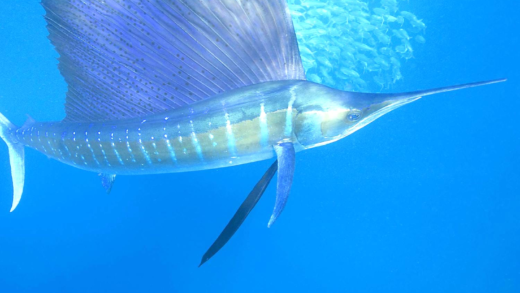Mysterious marine animals possess unique features that aid their survival in extreme ocean conditions. Their adaptations include bioluminescence and camouflage. Scientists study these creatures using methods like remote sensing and environmental DNA analysis. Pictures of these animals can be found in online databases, social media, and documentaries. Aquariums and marine science centers provide opportunities to learn about marine life through exhibitions and galleries.
Unique Features of Mysterious Marine Animals
Mysterious marine animals captivate our imagination with their unique features. These creatures often possess adaptations that allow them to survive in the depths of the ocean, where light is scarce and pressure is immense. Some remarkable traits include:
- Bioluminescence: Many deep-sea animals, like the anglerfish, use bioluminescence to attract prey or communicate with others.
- Camouflage: Species such as the octopus can change color and texture to blend into their surroundings, evading predators.
- Extreme Size Variations: From the tiny dwarf lanternshark to the colossal blue whale, the size range is vast, showcasing unique evolutionary paths.
These features not only help these animals survive but also play a crucial role in their ecosystems. The study of these fascinating creatures allows scientists to understand biodiversity and the complex interactions within marine environments.
Survival Strategies in the Deep Ocean
Surviving in the deep ocean is a daunting task for any creature. Mysterious marine animals have evolved various strategies to thrive in these extreme conditions. Key survival tactics include:
- Pressure Resistance: Many deep-sea creatures have flexible bodies that withstand high pressure.
- Slow Metabolism: Species like the gulper eel can survive long periods without food due to their slow metabolic rates.
- Specialized Diets: Some animals, such as deep-sea scavengers, feed on the remains of other creatures, making the most of limited resources.
These adaptations illustrate how life can flourish in the harshest environments. Understanding these survival strategies helps researchers develop insights into potential life on other planets.
Differences Between Mysterious and Common Sea Creatures
The distinction between mysterious marine animals and common sea creatures lies in their adaptations and habitats. Mysterious species often exhibit features that are not seen in more familiar marine life. Some differences include:
- Habitat Depth: Mysterious creatures typically reside in deeper waters, while common species are often found in shallower, more accessible regions.
- Behavior: Uncommon behaviors, such as unique mating rituals or feeding methods, set mysterious animals apart.
- Physical Characteristics: Many mysterious species have unusual shapes or colors that help them survive in their specific environments.
Recognizing these differences enhances our appreciation for marine biodiversity and the ecological roles these enigmatic creatures play.
Fascinating Behaviors of Mysterious Marine Animals
Mysterious marine animals exhibit a range of intriguing behaviors that set them apart from their more common counterparts. These unique behaviors often play critical roles in their survival and reproduction. For instance:
- Bioluminescent Displays: Creatures like the deep-sea jellyfish use bioluminescence not just for attracting prey, but also to communicate with potential mates or scare off predators.
- Complex Mating Rituals: Many species engage in elaborate courtship dances. The male seahorse, for example, performs a mesmerizing dance with the female that can last for hours.
- Social Structures: Some marine animals, such as dolphins, form intricate social groups, demonstrating teamwork and communication that are essential for hunting and protection.
These behaviors highlight the adaptability and intelligence of these elusive creatures. Understanding their fascinating behaviors contributes to our knowledge of marine ecosystems and the evolutionary processes that shape them.
The Ecological Importance of Elusive Marine Animals
Mysterious marine animals play vital roles in their ecosystems, often serving as indicators of environmental health. Their presence or absence can signal changes in the marine environment. Key ecological roles include:
- Predation and Competition: Many mysterious species are apex predators, helping to maintain the balance of marine life by controlling the populations of other species.
- Food Sources: They often serve as crucial food sources for larger marine animals, including humans. For example, deep-sea fish are a staple in many fishing industries.
- Nutrient Cycling: Creatures like the giant squid contribute to nutrient cycling through their feeding habits, which helps sustain the overall health of marine ecosystems.
The ecological contributions of these animals underscore the importance of their conservation. Protecting mysterious marine creatures is essential for maintaining biodiversity and the health of our oceans.
Legends and Myths About Sea Creatures
Mysterious marine animals have inspired countless legends and myths throughout history. These stories often reflect humanity’s fascination with the unknown depths of the ocean. Some notable examples include:
- The Kraken: This legendary sea monster, said to dwell off the coasts of Norway and Greenland, was believed to drag entire ships beneath the waves.
- Mermaids: Often depicted as beautiful women with fish tails, mermaids have been a symbol of mystery and allure, captivating sailors for centuries.
- The Loch Ness Monster: This elusive creature, rumored to inhabit Scotland’s Loch Ness, has sparked numerous expeditions and debates about its existence.
These myths not only entertain but also reflect cultural perceptions of the ocean and its inhabitants. They remind us of the mysteries that remain to be uncovered in our oceans, encouraging continued exploration and study of marine life.
How Scientists Study Mysterious Marine Animals
Mysterious marine animals are often elusive, making their study a challenging yet fascinating endeavor. Researchers employ various methods to uncover the secrets of these deep-sea dwellers. Some of the primary techniques include:
- Remote Sensing: Using satellites and underwater drones, scientists can gather data about marine habitats and monitor changes over time.
- Submersibles: These manned or unmanned vehicles allow researchers to explore deep ocean environments and observe animals in their natural habitats.
- Environmental DNA (eDNA) Analysis: Collecting water samples can reveal genetic material from marine organisms, providing insights into biodiversity without needing to capture the creatures.
- Acoustic Monitoring: By deploying hydrophones, researchers can record sounds made by marine animals, helping to understand their behavior and communication.
Through these innovative methods, scientists are slowly piecing together the puzzle of mysterious marine life, contributing to our understanding of deep-sea ecosystems and the creatures that inhabit them.
Where to Find Pictures of Mysterious Marine Animals
If you’re looking to explore the stunning world of mysterious marine animals visually, there are numerous resources available. Here are some great places to find captivating images:
- Online Databases: Websites like National Geographic and MarineBio feature high-quality images and articles about marine life.
- Social Media: Platforms like Instagram and Pinterest are treasure troves of stunning marine photography, often shared by marine biologists and photographers.
- Documentaries: Films produced by organizations like BBC Earth showcase the beauty and mystery of ocean life with breathtaking visuals.
- Marine Life Exhibitions: Visiting aquariums and marine exhibitions can provide firsthand experiences and opportunities to capture your own images of these incredible creatures.
Exploring these resources will not only satisfy your curiosity but also deepen your appreciation for the complex beauty of marine ecosystems.
Exploring Marine Life Through Galleries and Exhibitions
To learn more about mysterious marine animals, visiting galleries and exhibitions is a fantastic way to engage with marine life. Here are some avenues to explore:
- Aquariums: Major aquariums, like the Aquarium of the Pacific and Georgia Aquarium, feature exhibits dedicated to various marine species, including the mysterious and unique.
- Marine Science Centers: Many science centers host exhibitions that educate the public about marine biology, conservation efforts, and the importance of preserving ocean habitats.
- Traveling Exhibitions: Keep an eye out for traveling exhibitions that focus on ocean life, often featuring interactive displays and live demonstrations.
- Online Virtual Tours: In the digital age, many institutions offer virtual tours of their exhibits, allowing you to explore marine life from the comfort of your home.
Engaging with marine life through these platforms not only provides knowledge but also fosters a deeper connection to the ocean and its inhabitants.





Comments are closed.